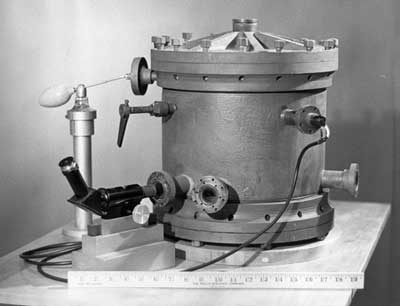
I've made three different periscopes of the same length:
1. A periscope sealed on the end that goes into the water and is thus filled with air. (This could be sealed on both ends as with the original but it is not necessary.)
2. A periscope sealed on both ends and filled with water.
3. A periscope not sealed on either end which allows the water to fill it.
The periscope to be filled with water has a hole in it that fits a rubber stopper. I was surprised how much water the periscope took and you do have to rock the perisope back in forth to move the bubbles around. The periscope has to be filled with enough water to submerge both mirrors. I also quickly found that the hot glue leaked on the "sealed" ends. But the leak was slow enough that I was still able to conduct the experiments initially.
 |
| On the left, viewing a small tiger toy through the air filled periscope and on the right viewing it through the water filled periscope without both mirrors submerged. |
I expected the water filled periscope to be blurry, and it was, looking about the same as trying to view something under choppy water from above. The pictures were difficult to get with a camera phone as the images in the eyepiece mirrors were quite small. I found that the water level had dropped in the water-filled periscope so that only the bottom mirror was submerged. I had to try holding the periscope horizontally to keep both mirrors submerged in water. I found that the toy could not be directly underneath the mirror and be seen out of the other end.
At first I thought it was refraction, but the medium did not change as the light traveled from the water in the bucket to the water in the periscope. After thinking about it for awhile I realized that although I had planned to hold the periscope horizontally as per the picture below I did not hold it perfectly parallel to the floor. This would account for the apparent shift in position as the mirror was aimed at the toy but not directly above it. Now I'm happy my husband tried to take an "embarrassing" photo of me experimenting in my pajamas.
I did recreate the water filled experiment being sure to keep the periscope more horizontal and found the mirror to be nearly right above it. After some trial and error, a better camera and more caulking on the water filled periscope, I was able to get clearer images.
I found that even with caulking on the ends because the clear plastic circle sat on top of the 90-degree elbow instead of inside it as with my other model it was never going to be perfectly sealed. When I presented this at the Fall 2015 NCNAAPT Meeting & Conference at Sacramento State my water-filled periscope leaked quite a bit.
Through that presentation I was able to refine my plan for using these periscopes in class a bit more. Several members enjoyed playing with my periscopes but then asked, "These are great, but what are you going to do with them?"
I've decided that the best use of my periscopes is as a discrepant event. Students can either look through the periscopes individually or the image can be seen through a document camera. I can show students the view through the air-filled periscope which produces a clear image. Then I can show them the view through the periscope open to air and water which produces a blurry image. Based on these two experiences I can ask students what they would expect to see from a water filled periscope. After they have a chance to discuss it they can actually see the image through the water filled periscope which is about as clear as the air-filled periscope. I hope to lead this into a discussion about refraction.
The air-filled and water-filled periscopes produce about the same image because there is no refraction between the object, mirrors and then your eye. (Consider the small change through the plastic circles to be negligible.) Only in the periscope open to water and air do you see refraction at the water-air boundary that affects the clarity of the image you see.

































